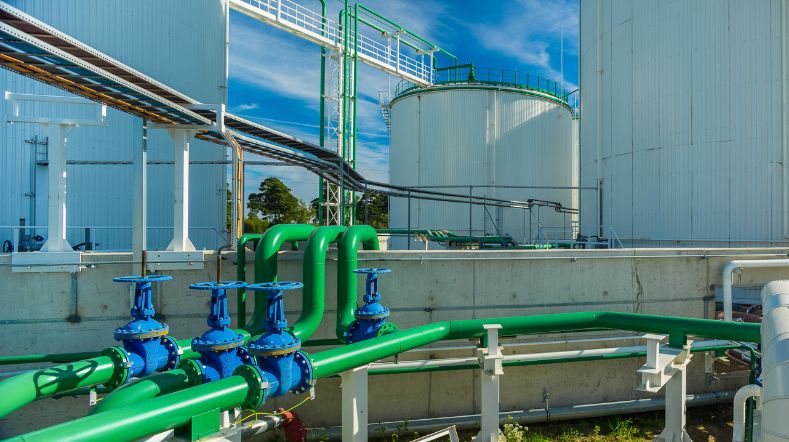Energy infrastructure and transport
The energy transition demands major changes in how we manage energy. Electricity grids are reaching their limits, we aim to reduce dependence on energy imports, and at the same time, greenhouse gas emissions must be significantly reduced. Robust energy infrastructure and transport systems are essential to achieving this. Together with our partners, we are developing infrastructure that safely, efficiently, and sustainably transports CO₂ and hydrogen across land and sea.
Why invest in energy infrastructure?
Our current energy infrastructure is already facing regular challenges. For instance, excessive electricity demand or supply leads to grid congestion. Or there is a willingness to capture and store CO2, but transport costs are too high. These issues will only become more frequent in the future.
That’s why it’s crucial to invest in energy infrastructure and transport now, before it’s too late. Safe, efficient, and affordable infrastructure can help reduce CO₂ emissions, lower import dependency, and accelerate the energy transition. Smart reuse of existing infrastructure plays a key role in this.
To meet climate targets, CO₂ emissions must be reduced. This requires a shift from fossil fuels to sustainable energy sources. Efficient infrastructure is vital to enable and accelerate this transition.
Without reliable transport networks, we cannot deliver renewable energy from production sites (like offshore wind farms) to end users (such as industrial clusters or residential areas). The right infrastructure also allows for energy storage during periods of surplus, making it available when needed—reducing reliance on fossil fuels.
With current geopolitical tensions, domestic energy production is becoming increasingly important. The Netherlands is currently highly dependent on imported fossil fuels, which makes the country vulnerable to international conflicts and price fluctuations.
By enabling the efficient transport and storage of sustainably produced, local energy—such as offshore wind power—we can reduce our reliance on energy imports from other countries.
Robust energy infrastructure accelerates the energy transition. Without suitable transport options, companies are less inclined to invest in sustainable energy. Reliable infrastructure provides certainty and encourages investment in renewable energy, which in turn can lead to increased demand for transport capacity and innovative solutions.
The Netherlands has an extensive natural gas network that is being used less and less. By smartly repurposing this existing infrastructure for new energy carriers—such as adapting gas pipelines for hydrogen or CO₂ transport—we can reduce costs, minimize environmental impact, and speed up the transition.
Through technical research into material suitability, required modifications, and safety standards, we ensure that this infrastructure can be safely given a second life.
What we do
The transition to a sustainable energy system requires more than just new energy sources. It requires smart cooperation between technologies and infrastructures.
TNO is working on integrated solutions for system integration, CO2 transport and hydrogen infrastructure. From combining electrons and molecules to safely storing and transporting CO2 and hydrogen: we bring science and practice together to make the energy system of the future reliable, flexible and efficient.
System integration involves connecting different energy carriers into a single, coherent system. At TNO, we explore how electrons (electricity) and molecules (such as hydrogen and green gas) can work together optimally.
We develop methods to combine the strengths of both types of energy carriers. The electrical system is efficient for direct energy delivery via cables, while molecular systems like hydrogen are well-suited for energy storage.
A practical example: wind energy can be converted into hydrogen via electrolysis when there is a surplus of electricity. This hydrogen can be stored and later reconverted into electricity, for instance when demand is high. Through system integration, we are building an energy system that is more flexible, reliable, and cost-efficient than if these systems operated independently.
CO2 capture and storage (CCS) is essential in the fight against climate change, especially during the transition period in which fossil fuels are still in use. CO₂ can be captured both directly at the emission source and from the atmosphere, helping to reduce both emissions and atmospheric concentrations.
However, transporting CO2 from capture to storage presents challenges. CO2 behaves differently from other gases, and existing infrastructure cannot be directly repurposed for CO2 use. Pressure changes and temperature fluctuations can cause unexpected phase transitions, and impurities in CO2 streams may lead to corrosion of infrastructure.
TNO has developed advanced flow assurance models that allow us to predict how CO2 behaves under various conditions, helping to define the safe temperature and pressure ranges for transport. Our unique test facility, the Colorado Flow Loop, serves as a valuable intermediate step between theoretical research and full-scale implementation. It enables us to simulate and measure CO2 behavior under different conditions.
We also conduct pulsation and vibration measurements on existing equipment to determine how compressors, valves, and other components can function optimally when used in CO2 transport infrastructure.
Read more about our work on CO2 infrastructure and transport.
Hydrogen can play a key role in balancing our energy system by storing surpluses of renewable electricity and offering industries an alternative to fossil fuels. To unlock this potential, a robust system for production, transport, and storage is essential.
We are involved in various projects aimed at developing a national network of pipelines for hydrogen distribution between industrial clusters. Wherever possible, we make use of existing gas infrastructure, which helps reduce costs and speeds up deployment.
In the North Sea, we are also exploring the potential to repurpose old gas pipelines for hydrogen transport and are developing new concepts for offshore hydrogen production.
To assess whether (existing) infrastructure is suitable for hydrogen transport, we test materials and components under high pressure in our facilities. We also develop models to simulate and better understand hydrogen behavior in pipelines. Based on these models, we provide recommendations on the modifications needed to infrastructure components to ensure safe and efficient transport.
Our projects
As an independent knowledge partner, TNO is involved in a wide range of projects related to energy infrastructure and transport. In these projects, we often bring together various stakeholders—from grid operators and industrial partners to government bodies—to jointly address the challenges posed by new energy carriers such as hydrogen and CO2. Many of our projects are public-private partnerships, where our multidisciplinary expertise allows us to act as orchestrator and connector.
PosHYdon is a demonstration project in which TNO developed an offshore hydrogen production facility, located approximately ten kilometers off the coast of The Hague. The installation, with a capacity of one megawatt, produces green hydrogen from seawater using offshore wind energy. Installed on Eni’s electrified Q13a production platform, the project integrates offshore wind, gas, and hydrogen.
TNO developed the concept, is conducting the testing program, and is assessing the feasibility of large-scale deployment around 2030–2035. A key advantage is that the hydrogen can be transported to shore via existing gas pipelines, which is more cost-effective than laying new electricity cables.
Read more about the PoshHYdon project.
The North Sea Energy Program focuses on making energy production in the North Sea more sustainable, with innovative solutions for offshore wind and hydrogen production.
Read more about the North Sea Energy programme.
HyDelta is a large research program focused on the development of large-scale electrolysis for the production of green hydrogen.
OESTER explores the potential of offshore hydrogen production using wind energy, with a focus on scaling up technologies and integrating them into the energy system.
Read more about OESTER.
Hy3+ aims to improve the efficiency and cost-effectiveness of electrolysis technologies for hydrogen production, with the goal of enabling large-scale application.
Read more about Hy3+.
HEROW supports the development of offshore hydrogen production through knowledge sharing, innovation challenges, and training materials for the industry.
Read more about HEROW.
Porthos is an innovative project for the large-scale storage of CO₂ beneath the North Sea, forming part of the Dutch strategy to decarbonize industry.
Read more about Porthos.
Aramis focuses on developing infrastructure for the large-scale storage and transport of hydrogen, which is essential for the energy transition in the Netherlands.
Read more about Aramis.
The Colorado Flow Loop is a test facility for advanced technologies in the energy sector, such as hydrogen and CO₂ storage, supporting the transition to sustainable energy.
Read more about the Colorado Flow Loop.
Collaborating with TNO
In the field of CO2 transport and infrastructure, we collaborate with both national and international partners. Our projects involve various forms of cooperation:
- One-on-one collaborations, for organization-specific challenges or when confidentiality is required.
- Joint Industry Projects (JIPs), where we bring together like-minded partners to address shared sector challenges. JIPs promote knowledge exchange, broaden research scope, accelerate progress, and reduce costs.
- European research projects, where we work in consortia with sometimes dozens of partners on broader innovations in the CO2 transport chain, often (partially) funded by the European Union.
Interested in collaborating?
As an independent knowledge partner, TNO supports the development, testing, and implementation of innovative solutions for both hydrogen and CO₂ transport. With our expertise in system integration, advanced modelling, and unique test facilities such as the Colorado Flow Loop, we contribute to the reliability, efficiency, and safety of energy infrastructure and transport.
Curious to find out what we can do for your organisation or project? We’d be happy to start the conversation.
Get inspired
Tomorrow’s hydrogen production and infrastructure: building towards a secure and robust energy system

CO2 infrastructure and transport


Energy system with systems integration


Expansion of energy infrastructure


European Industry & Energy Summit 2021

